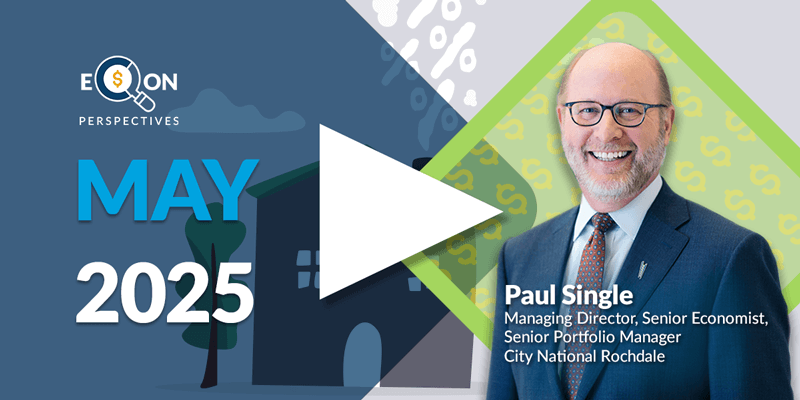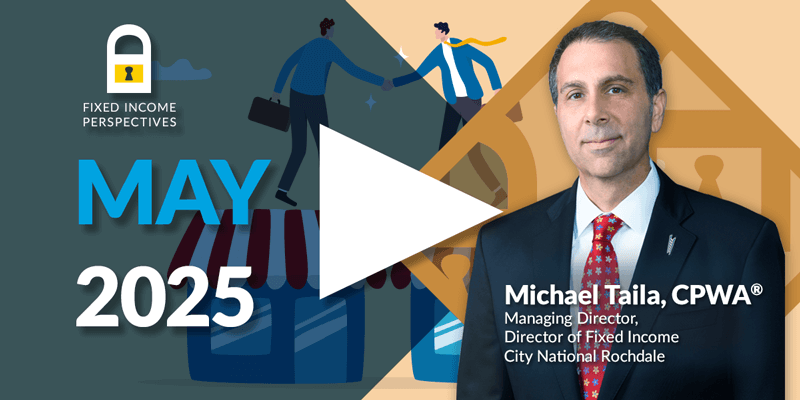-
Market Perspectives
Not So Spooky
October 2024
- Filename
- Market Perspectives OCTOBER 2024.pdf
- Format
- application/pdf
TRANSCRIPT
Major stock indices appeared not to have been spooked by the historically volatile months of September and October, continuing their respective advances for the year.
As of filming, the S&P 500, the Dow Jones Dividend Select and the Morgan Stanley All Country World Indices, just to name a few, are all comfortably in double-digit positive territory year to date. Since we last spoke, the Fed commenced, finally, on the highly anticipated path to lower Fed funds rates, cutting by 50 basis points at the Sept. 18 meeting. The other hot topic is, of course, the election.
This will be the last filming before Nov. 5, so this month, let's focus on these two headline-grabbing topics: monetary policy and the election.
As previously stated, the Fed cut the Fed funds rate by 50 basis points in September. City National Rochdale expects an additional 25-50 basis points before year end. We think there's a chance, given the election and the strength of recent economic data, plus slightly higher recent inflation reads, that the Fed could stand pat in November.
S&P 500 Performance Around Initial Fed Rate Cuts

Sources: Bloomberg, NDR Research, as of September 2024.
Information is subject to change and is not a guarantee of future results.
Slow Cycles: 02/05/1954, 11/15/1957, 06/10/1960, 11/19/1971, 05/30/1980, 11/21/1984, 07/06/1995, 09/29/1998
Fast Cycles: 11/13/1970, 12/09/1974, 11/02/1981, 06/06/1989, 01/03/2001, 09/18/2007, 07/31/2019
Chart 1, 1:23— The pace of further easing is likely to be measured and data driven. Regardless of whether we get one cut or two cuts before year end, a multiyear measured easing cycle should be supportive for the economy and financial markets. Historically, stocks perform better when rate cuts are slow and steady. Such a pace generally suggests a proactive policy rather than one reacting to an economic concern or financial market shock.
The Stock Market and Fed Rate Cuts
Chart 2: S&P 500 Performance After First Fed Rate Cut

Table Sources: Emergency Cuts = Black Monday (1987), Russian Ruble/LTCM Crisis (1998), COVID (2020)
Chart Sources: FactSet, St. Louis Fed.
Information is subject to change and is not a guarantee of future results.
Chart 2, 1:52— In other words, it is important to understand why the Fed is cutting. Historically, if cuts are in response to a recession, the S&P 500 performance has been relatively weaker 3, 6 and 12 months after the first rate cut. In periods characterized as normalization, it has performed better. Cuts in response to an emergency measure relatively well because they usually follow a market that has dropped materially.
Shifting to the election. With the days counting down to Nov. 5, polls and prediction markets disagree on the potential outcome. Traditional polling indicates a near-even split with a slight lead to candidate Harris. Prediction markets like Polymarket and Kalshi show candidate Trump leading.
Polymarket has seen a recent large influx in wagers with speculation surrounding a mystery trade betting heavily on Trump. Critics argue that prediction markets are influenced by financial stakes and may not accurately represent voter behavior compared to polls.
The takeaway is that the election forecast is cloudy and uncertain.
S&P 500 Performance Since 1928
Presidential Election Years vs. Non-election Years

Source: NDR Research, as of September 2024.
Information is subject to change and is not a guarantee of future results.
Chart 3, 3:00— You will recall multiple references to the three T’s: tariffs, taxes and treasuries. But what can we expect from a macro stock market perspective?
Historically, the S&P 500 has experienced greater uncertainty and volatility in election years. Year to date, we have experienced a strong S&P 500, up more than 20% as of filming, but we have had some volatility.
There was one period at the beginning of the second quarter, another starting in mid-July and then a smaller drop at the beginning of September. Perhaps election uncertainty played some role. However, there were economic and financial factors as well. The key point of this chart is that post-election, the S&P 500 tends to trend back with non-election-year behavior.
S&P 500 Performance
Since 1933

Source: Bloomberg, as of September 2024.
Information is subject to change and is not a guarantee of future results.
Chart 4, 3:49— And most importantly, presidential party control has had less of an impact on the stock market than many think. You've heard us say this many times — corporate profits, interest rates and the direction of monetary policy matter much more.
I look forward to putting those charts into storage until 2028.
We are now entering into the heart of third quarter earnings season, and next month, we'll shift our focus to how earnings season played out, if any revisions are needed to our earnings growth outlook, and importantly, whether there is any impact to the outlook for stocks.
Important Information
The views expressed represent the opinions of City National Rochdale, LLC (CNR) which are subject to change and are not intended as a forecast or guarantee of future results. Stated information is provided for informational purposes only, and should not be perceived as personalized investment, financial, legal or tax advice or a recommendation for any security. It is derived from proprietary and non-proprietary sources which have not been independently verified for accuracy or completeness.
While CNR believes the information to be accurate and reliable, we do not claim or have responsibility for its completeness, accuracy, or reliability. Statements of future expectations, estimates, projections, and other forward-looking statements are based on available information and management's view as of the time of these statements. Accordingly, such statements are inherently speculative as they are based on assumptions which may involve known and unknown risks and uncertainties. Actual results, performance or events may differ materially from those expressed or implied in such statements.
Past performance or performance based upon assumptions is no guarantee of future results.
All investing is subject to risk, including the possible loss of the money you invest. As with any investment strategy, there is no guarantee that investment objectives will be met and investors may lose money. Diversification does not ensure a profit or protect against a loss in a declining market.
Equity investing strategies & products. There are inherent risks with equity investing. These risks include, but are not limited to stock market, manager or investment style. Stock markets tend to move in cycles, with periods of rising prices and periods of falling prices.
Fixed Income investing strategies & products. There are inherent risks with fixed income investing. These risks include, but are not limited to, interest rate, call, credit, market, inflation, government policy, liquidity or junk bond risks. When interest rates rise, bond prices fall. This risk is heightened with investments in longer-duration fixed income securities and during periods when prevailing interest rates are low or negative.
City National Rochdale, LLC is an SEC-registered investment adviser and wholly-owned subsidiary of City National Bank. Registration as an investment adviser does not imply any level of skill or expertise. City National Bank is a subsidiary of the Royal Bank of Canada.
© 2024 City National Rochdale, LLC. All rights reserved.
Index Definitions
The Standard & Poor’s 500 Index is a market capitalization-weighted index of 500 common stocks chosen for market size, liquidity, and industry group representation to represent US equity performance.
Dow Jones Industrial Average: U.S. Select Dividend Index aims to represent the U.S.'s leading stocks by dividend yield.
Morgan Stanley All Country World Index (MSCI ACWI): A stock index designed to track broad global equity-market performance. Maintained by Morgan Stanley Capital International (MSCI), the index comprises the stocks of nearly 3,000 companies from 23 developed countries and 24 emerging markets as of Dec. 29, 2023.
Polymarket is a financial exchange that allows users to place bets on future events, such as political outcomes, weather patterns, and economic indicators. It is the world's largest prediction market and was launched in 2020.
The Bloomberg Barclays U.S. Corporate High Yield Index is an unmanaged, U.S.-dollar-denominated, nonconvertible, non-investment-grade debt index. The index consists of domestic and corporate bonds rated Ba and below with a minimum outstanding amount of $150 million.
Stay Informed.
Get our Insights delivered straight to your inbox.
Put our insights to work for you.
If you have a client with more than $1 million in investable assets and want to find out about the benefits of our intelligently personalized portfolio management, speak with an investment consultant near you today.
If you’re a high-net-worth client who's interested in adding an experienced investment manager to your financial team, learn more about working with us here.



